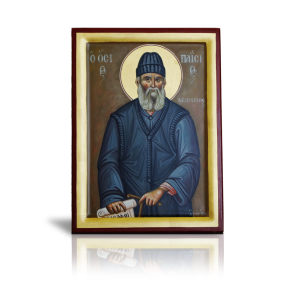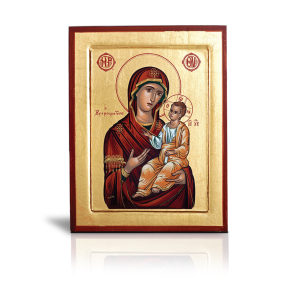
The Birth of the All-holy Virgin Mary.
In the birth of the All-holy Virgin Mary we have the beginning of the the sacred history of the New Testament, the history of our salvation. It was the preparation for the incarnation of the Son of God, the advent of God in the flesh. Thereby that human nature, which was to receive God Himself, is made ready, that the race of man might be saved. This human nature had to be made worthy of God, had to be holy and immaculate; it needed a holy origin, upbringing and development. Her being chosen of God rests in the fact that she of all mankind must needs give to God reciprocally the common nature of mankind.
The time of the Virgin’s birth is the time of the awaiting of the coming of the Messiah, Christ. Her parents are Joachim and Anna; he was of the kingly, and she of the high priestly, lineage.[1] The spouses, well advanced in age did not have any children. This was regarded as a disgrace among the people, and for this reason they were considered as deprived of God’s blessing.
In abasement and humility they desired a child, as a mercy from God and to take away their disgrace and reproach among the people. In this way, humility, prayer and the holy promise to dedicate their child to God for service in the Temple were the spiritual prerequisite of its birth. And God heard them, and to them there was born a daughter, whom they called Mary. The name Mary is a translation from the Hebrew and it signifies: high, exalted over all.
The Mother of the Lord was in actuality born of pious parents, and indeed could only be the fruition of their spiritual endeavour, their heartfelt striving, and their tearful prayers to God. A spiritual existence could only be the fruit of the spirit, initiated not only according to the natural, blind inclinations of the flesh and the natural laws of the requirements of the nature of the flesh, but according to the aspirations of the spirit and through the action of the special mercy and grace of God for people, who were already elderly and whose flesh was withering, but who were living according to the spirit. If the origin be holy, so shall the whole, and if the root be holy, so are the branches (Rom 11:16). From a holy root there came forth a holy fruit.
An example of a promise with reference to a future child is given by the barren Hannah [Anna], the mother of the holy Prophet Samuel. And she was in bitterness of soul, and prayed unto the Lord and wept sore. And she vowed a vow, and said, O Lord of Sabaoth! if Thou wilt indeed look upon the affliction of Thy handmaid, and remember me, and not forget Thine handmaid, but wilt give unto Thine handmaid a man child, then I will give him unto the Lord all the days of his life… (1 Kings [Samuel] 1:10-11). Joachim and Anna also followed the example of the parents of the righteous Samuel.
The mother of the Saviour, a King according to His earthly descent and according to His eternal ministry, and High Priest of the future good things, naturally, had in herself to compass the two lines of descent, the royal and high priestly, in her people. By her father she was of the tribe of Judah and the house of David, and through her mother she was of the tribe of Levi and the house of Aaron. Although Christ came forth from a mother alone without a father, and Joseph was only the betrothed husband of Mary, the protector and guardian of her virginity and only the nominal father of the Saviour, yet the Saviour was not simply nominally of the royal house, but was in reality, through his mother and according to the flesh, of this house, of which in the person of David it had been said of the Lord, thy throne shall be established unto the ages (2 Kings [Samuel] 7:16). This throne could not be disestablished, and Mary actually was herself actually descended from the house of David that she might be the mother of the Lord.
The entrance Into the Temple of the All-holy Virgin Mary.
When Mary was fully three years old, Joachim and Anna fulfilled their vow and brought her to the Temple in Jerusalem, that she might stay there in the Lord’s service. The maiden, thus consecrated to God, was brought up at the Temple and lived nearby in the special apartments [attached thereto]. Customarily the high priest received and blessed all those consecrated to God at the gates of the Temple, but when they brought in the infant Mary, he, by the special inspiration of the Holy Spirit, led her into the Temple’s Holy of Holies, where he himself was permitted to enter only once a year.
The All-holy Virgin Mary lived at the Temple until her fourteenth year, continuing in labours, in prayer and in the reading of the word of God, in the fulfilment of every virtue. But at that time it was necessary for her either to return to her parents or be given in marriage. As Joachim and Anna had at that time already reposed, and the All-holy Virgin had no desire to enter marriage, the priests of the Temple betrothed her to a distant relation, the elder Joseph, for him to be the guardian of her virginity.
The All-holy Virgin was consecrated to the Lord after fulfilling three years, following the example of the Old Testament injunction regarding the fruits of the trees: “Three years shall it be uncircumcised unto you, it shall not be eaten of But in the fourth year all the fruit thereof shall be consecrated for the festivals of the Lord” (Lev. 19:23-4).
Thus did Hannah say of her son Samuel: “When the child shall be taken from the breast and weaned, then Will I bring him that he may appear before the Lord and there abide for ever.” “And she brought him unto the house of the Lord in Silom, and the child was still an infant … and she said: For this child I prayed, and the Lord hath fulfilled my petition, which I asked of Him; therefore also have I given him over to the Lord all the days of his life, that he may serve the Lord” (1 Kings [Samuel] 1:21-28). In a like spirit, we must suppose, Mary’s parents brought and gave over their little child in the Temple for service.
How far this comparison is true and represents the actual entry of the All-holy Virgin Mary into the Temple can be judged from the fact that that the All-holy Virgin herself sang her festive song (“My soul doth magnify the Lord”) and her thanksgiving to God for her election to be His mother according to the flesh following the example of the song of Hannah, the mother of the Prophet Samuel (1 Kings 2:1-10): “My heart rejoiceth in the Lord; mine horn is exalted in the Lord….” It is evident that certain of the most important verses in the composition of these wondrous hymns parallel each other. Furthermore, we can not only find parallels between the All-holy Virgin and the Prophet Samuel in their birth and in their being presented in the Temple, but also in the fact that Samuel sought out and anointed the child David, the originator of the royal house, for the kingship, and Mary gave birth to his last Descendent, the Messiah, the King of an Eternal Kingdom. The ministers of the same work had the same upbringing.
Everyone who has the Holy Spirit is a temple of God (1 Cor. 3:16; 6:19). In such a man, God abides by grace. But only in one person in the world did God Himself abide, in His very Being, in His nature, taking human nature and abiding in her—this one was the All-holy Virgin Mary. She is actually the Temple of God and the place of His presence and of His glory.
As she is thus herself the “Holy of Holies”—herself “the Ark”—, again the Lord shall be manifested (Ex. 22:25) unto the race of man, the All-holy Virgin does not simply enter the Temple but goes into the very Holy of Holies, behind the veil with its depictions of the Cherubims. Just as Simeon the God-receiver came by inspiration into the Temple to meet the Infant Lord (Luke 2:27), so also by the inspiration of God the high priest met the Virgin in an extraordinary way, and led her into the holy place, which corresponded to her. In “the chambers built round the walls of the Temple, round the Temple and the oracle (the Holy of Holies), there in the chambers built around at the sides” (3 Kings 6:5), which were by the second Temple, there it was that the All-holy Virgin spent her youth.
http://www.stspyridon.org.au/



